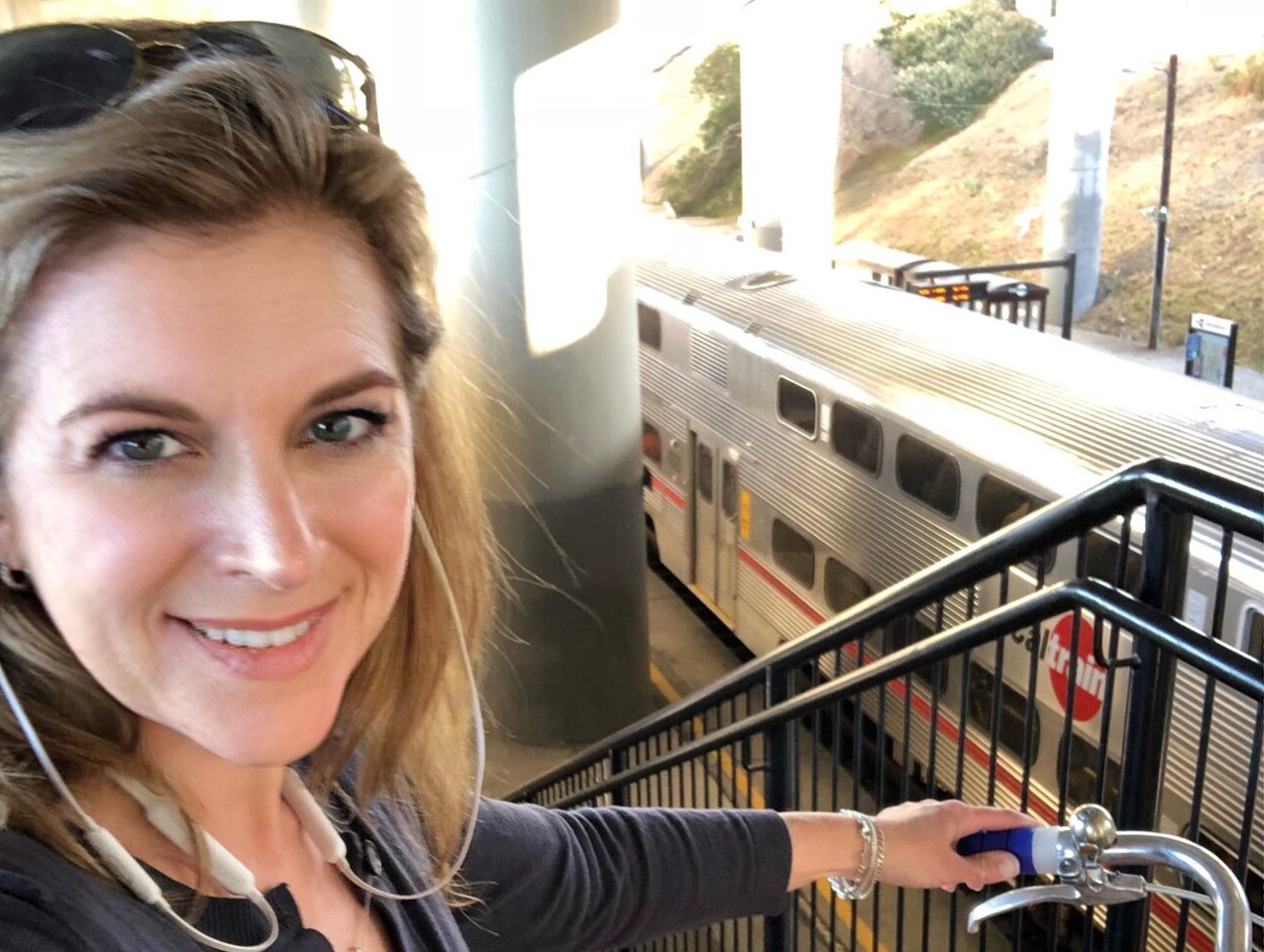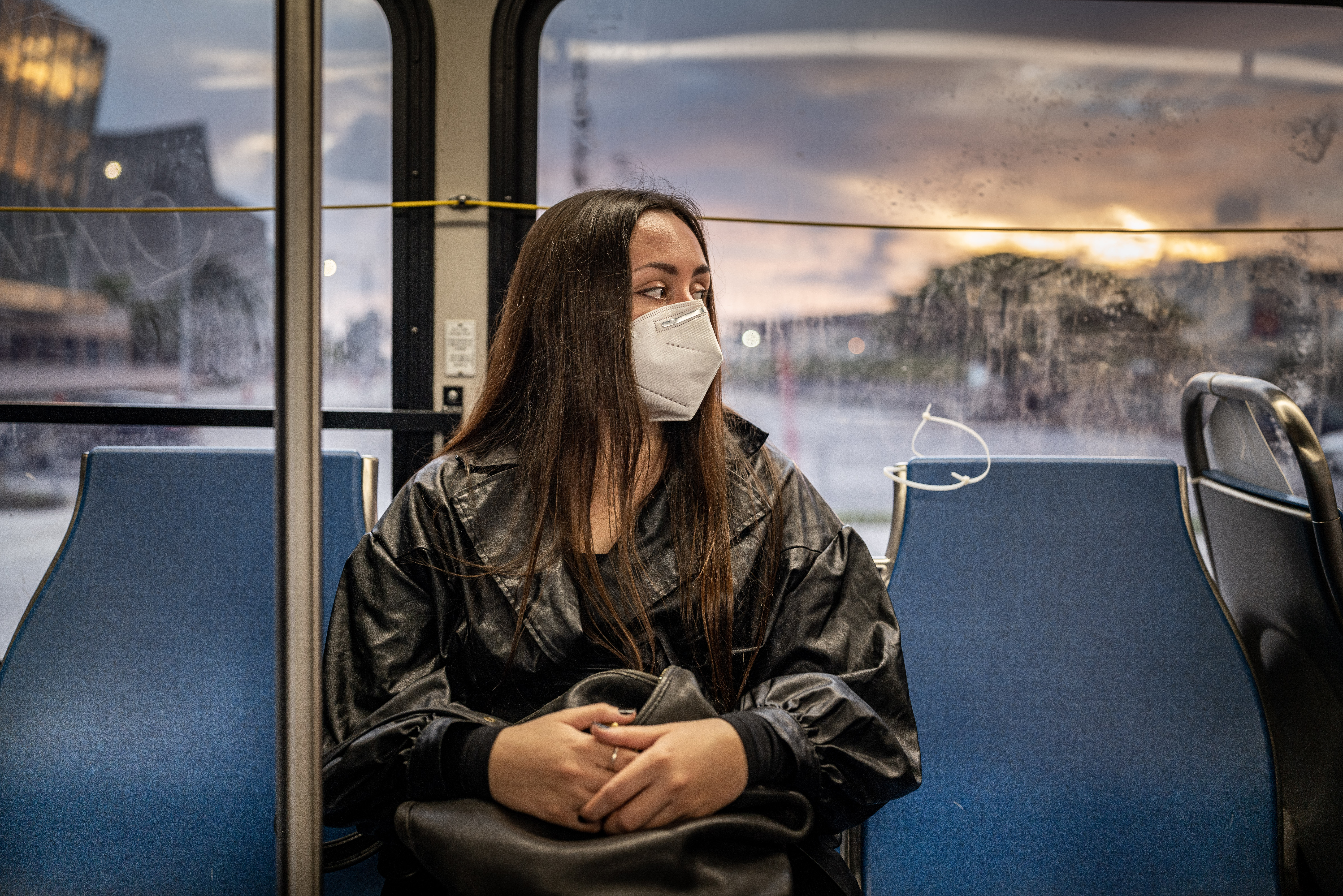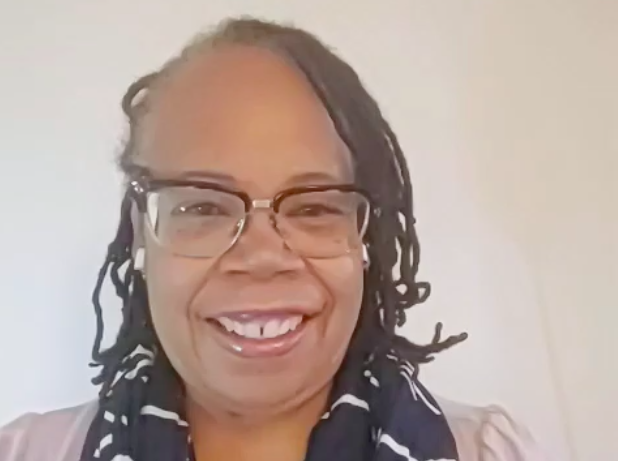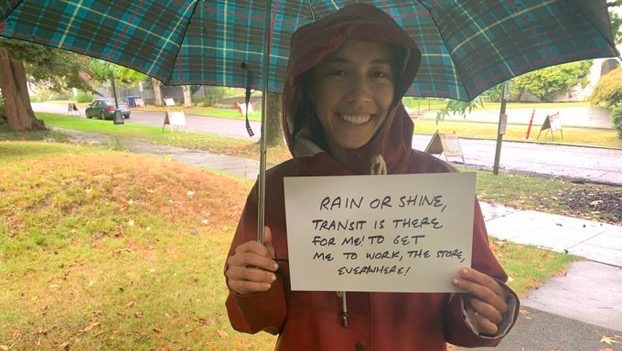
Transit Rider Storybook Campaign: Real People, Real Stories, Real Need for Transit
The COVID-19 pandemic brought home just how essential public transit is to our communities, our economy, and our future.
An estimated 2.8 million Americans in essential industries rely on transit to commute to work. Cities were able to survive the pandemic thanks to the mobility that transit provides.
Unfortunately, in most American cities buses and trains simply don’t come often enough or connect to enough places to serve as a reliable transportation option. Too many riders are stranded by service that is infrequent or unreliable, that costs too much or is inaccessible, or that eats up precious hours.
The pandemic exacerbated these problems, but it did not create them. Our transit woes reflect decades of misplaced priorities, disinvestment in Black and brown communities, and refusal to meet the needs of people with disabilities.
Larger and smarter investment could transform transit in this country. People could reach more places, faster, and spend less time and money commuting. This could lessen people's financial burdens, help them get to work and appointments on time, and allow them to spend more time with loved ones.
The stories shared below contain the personal accounts of riders in cities across the country. These riders tell us what transit means to them and how funding for faster, more frequent, and reliable service could change their lives.
California
Florida
Illinois
Maryland
New York
North Carolina
Ohio
Pennsylvania
California
 Chris Chavez, Long Beach, CA
Chris Chavez, Long Beach, CA
I was born and raised in Long Beach. Like many children here, I had asthma because the air is so polluted. On many indicators of poor air quality, we’re at the top among cities across the country. Asthma is assumed to be something that just happens, but like other respiratory conditions it’s worsened by air pollution -- and the predominant source of pollutants is transportation in the form of cars and trucks. So, good public transit is a health issue.
Pre-pandemic, I rode public transit every day into downtown LA, where I work as Deputy Policy Director of the Coalition for Clean Air, and I will get back onto transit again as soon as my office reopens. I also was a daily transit user when I worked at the State Capitol in Sacramento. There’s a light rail station right underneath the office building where I currently work. Transit is both more convenient and more affordable for me, especially with gas prices on the rise again.
My job takes me all over the region, to meetings with local officials, state officials in district offices, and down to the South Coast Air Quality Management District. I use public transit everywhere I go. Between going to work or to meetings, I’ve ridden every light rail and bus rapid transit line in LA Metro’s system.
As much as I count on public transit, I’ve seen ways we can improve our system. More consistent service is a perennial issue. It wasn’t until I went to Sacramento that I realized trains and buses run on a schedule. I’d also like to see more dedicated bus lanes. The light rail line I use was closed for about a year, and they replaced it with a shuttle bus in regular traffic. When they finally did create a dedicated lane, it saved a lot of time. Having zero emission buses is also very important for improving air quality. And, since I have a parent who lives in Orange County, I’ve learned that we need a seamless transition from county to county to make public transit a real option. My parent lives 10 miles away but it would take me an hour and half to get there on public transportation -- three times the drive on a normal day.
And equity remains a huge concern in LA’s transit system. One issue is prioritizing trains over bus service, because the train has tended to favor choice riders, whereas the bus tends to be more localized and serves low-income people. The primary goal of any transit system needs to be getting people where they need to go and helping those who need it to be mobile, for whom transit is a lifeline. That should be a top priority.
Stacey Randecker, San Francisco, CA
In the Bay Area, any loss of transit service threatens to upend my life, and my family’s life. I commute on Caltrain and my two teenage children ride San Francisco (SFMTA) buses to school. Without a stable source of guaranteed funding, I know both services are always at risk, and will never be used to their maximum potential.
My last job was with a company in Milpitas – a nearly two hour one-way trip using Caltrain and my bicycle from San Francisco to Silicon Valley. After a corporate lay-off, my ability to re-enter the labor force was threatened—first by the pandemic, now by Caltrain service. If Caltrain were to ever reduce operations, I would be unable to accept a job in Silicon Valley without buying a car. I’m unwilling to take that step, both because of the personal expense and the cost to our environment in carbon emissions.
With two kids in high school who participate in afterschool activities across the city, the city’s bus system has become a lifeline for our family. SFMTA has been absolutely vital to avoiding the expense of a car, and for my kids to participate in activities that are important to them. However, it has become increasingly more difficult for them to use transit. My daughter can adapt to changes in transit schedules more easily, but my younger son faces more obstacles. Can you imagine a 14 yr-old athlete having to get up before 6 am just to get on transit, and then having to spend over an hour commuting, when his destination is only a 15 minute drive away? That’s what my son goes through every time he commutes to his sports’ practices. For them to commute to school it takes about an hour through Muni, San Francisco’s railway system. We make it difficult for people to use transit, when the cheapest, fastest thing we should be able to do is take public transportation.
As a country, we spend billions of dollars every year building and maintaining highways and roads, but nowhere near enough supporting essential public transit services. I don’t understand why a region with this much wealth can’t have a seamless regional transit system. We need to have transit service that is reliable so people aren’t forced to rely on cars.
New buses and trains don't matter unless we have them running more and arriving and moving often Everytime we leave someone standing on a curb waiting for transit, we are pushing them to buy a car. The amount of money that is spent for an individual to buy, maintain, and fuel the vehicle is astronomical compared to how much they would spend on transit. I never would have made it during the pandemic if I also had to pay to sustain a vehicle.
To Speaker Nancy Pelosi, I urge you to support increased transit service for the Bay Area, and the nation as a whole.
Cynde Soto, Los Angeles, CA
My name is Cynde and I live in a beach town in L.A. County California. Riding transit allows me to live independently in the community, which is what we all want to do, right?
My wheelchair will not be able to get into a car or a taxi of any kind, so I rely on public transit. I ride the bus, the light rail and subway.
We have quite a few options here in LA County, which is a very good thing. However, the routes don’t always go where I need to go. For instance, I live in a bit of a food desert. So in order for me to go grocery shopping once a week i need to take at least 2 buses, and that can be very time consuming and super frustrating for me. So I have to get to the bus stop, get the ride, then go a couple more blocks actually to the grocery store, so that could take me like half a day, and I just think that’s ridiculous.
We should have more frequent bus scheduling, or maybe even just more buses period…One problem(?) that it could be solved with that is through microtransit, so that way, the rides are shorter and we could actually get to our destinations that are vital to living in our community.
Another issue I have in traversing the county is sidewalks, the path of travel to bus stops. The cities in LA Cty have not been keeping up with their infrastructure so the sidewalks are either non-existent or broken. Therefore if METRO could work with the cities, that could be eliminated - that problem.
I would also like to talk about bus shelters. Bus shelters are very important for everyone really. And in LA County it gets pretty hot, so I need shade, as a lot of people do. And I know that not all sidewalks can accommodate a shelter, however I’ve seen some new, exciting designs for various shelters that can accommodate smaller space. The rectangular, traditional shelters don’t really work for a lot of places, so that would be great.
Another problem that I have is overcrowding. The reason that we have overcrowding is there’s not enough buses or people don’t really know when the bus or rail is going to arrive. So if we had real time information about when our ride would be coming to us, it would be a lot less frustrating and people could better plan their trip out around town.
I think the last situation that we have concerns safety and policing. There has been a lot of conversation about equity and safety, the statistics show that more people of brown skin are criminalized for breaking the rules. I don’t think that’s right. I believe that we need fewer armed safety personnel, and more unarmed safety personnel. And what we really need is for security to have a different kind of mindset, a different education than “peace officers”. What we need are ambassadors or security people with social work backgrounds or people who do outreach with our unhoused residents because they have the specific training to help people. They can give resources, but they don’t have to have arms - it frightens people and I really don’t think it's needed anyway.
So, let’s get together our resources and our people and help America move.
Florida
China Carr, Miami, FL
I’ve been riding public transportation in Miami for 12 years, since 8th grade, relying on it to get to school and carry out my daily life.
As a college student and emerging professional I continued to rely on public transportation, despite it often running late, no-show busses, or delayed trains, public transportation was crucial to giving me access to a life beyond my neighborhood.
In 2020 I had to move from the neighborhood in Miami where I lived and grew up, because of a lack of access to busses and the Metrorail train. Without a car, I needed to move to a part of the city where busses and trains were more frequent and reliable.
Choosing to migrate to a more expensive but more accessible part of the city was a position I took to try and continue to broaden my access to jobs and improve my mobility, but in reality public transportation closer to the urban core was only minimally more reliable because public transportation city-wide is suffering.
When public transportation is lacking, or fails, you leave behind young professionals like myself and force us to move to cities and countries with better public transportation infrastructure. To me, investing in more public transit service and infrastructure would mean that I won't be forced to eventually leave my city entirely, and would allow me to carry out my day-to-day life.
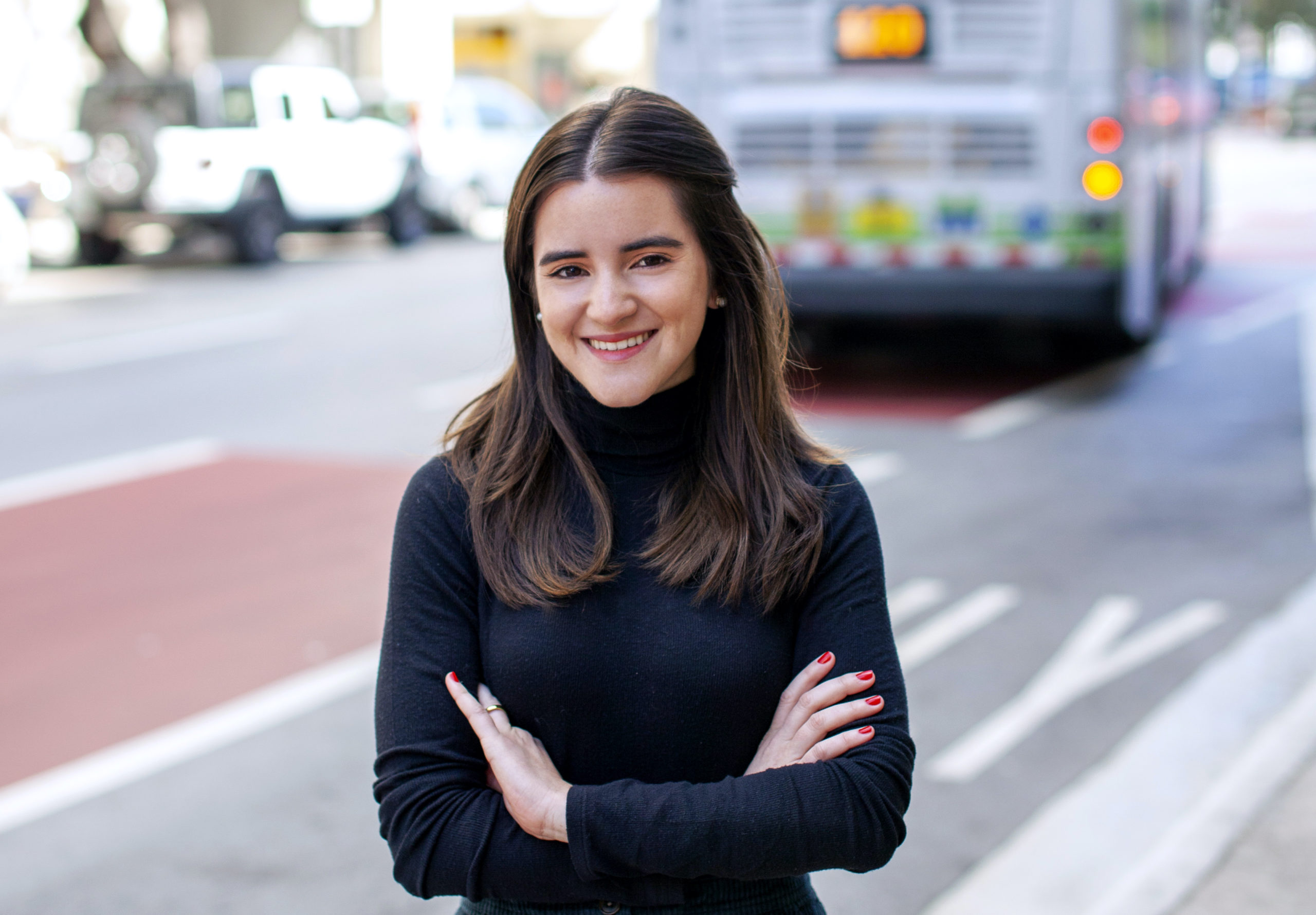
María Cristina Chicuén, Miami Beach, FL
As a resident of Miami Beach, FL who does not own a car, many may wonder how it is possible for me to exist in a place like Miami-Dade County, where not having a private vehicle at your disposal 24/7 can make or break your daily schedule.
Growing up in the suburbs of Miami-Dade, I too thought this way since public transit in South Dade was virtually non-existent, if not wholly unreliable for the majority of my adolescent years. In fact, it was not until I left Miami for college that I realized how our public transit system failed to meet the needs of most Miamians - myself included.
When I moved to Miami in 2019, I was fortunate to live in Downtown Miami, which is one of the few areas in the entire county that has frequent, reliable transit service. From buses to the metro rail, I found myself eager to explore my City without needing to buy a car. Not only was this a huge relief financially, it also helped me understand Miami in a different way by allowing for more chance encounters with fellow riders - encounters that are not possible behind the wheel of a car.
I am what is referred to as a “choice rider” since - if needed - I could purchase a car. There have been many times when I have thought of buying a car simply for how easy it would be to avoid getting left behind by a bus or skipping a crowded train. Yet, my belief in improving the public transit system has always served to stop me from leaving it behind.
Many in my community do not have this option, which is why saving transit - and improving it - is so critical. For thousands of Miamians, especially communities of color and low-income residents, transit is a lifeline - not just for getting to and from work, but for reaching hospitals, education centers, and, more broadly, connecting us to more opportunities.
Federal policy - as well as state and local - should reflect the need for greater investments in our public transit systems on par with investments in highways. Especially as our systems suffer from the long-lasting effects of the pandemic, a key component of building back better should prioritize the systems that move and connect residents. Strengthening our transit systems will not only help us reach our climate goals - of which public and mass transit is an essential element - it will also make a strong statement to residents across the United States about finding freedom outside of a private vehicle. Creating a true multimodal society is essential to being a more equitable society, and placing transit at the heart of this equation will help the United States achieve this vision and a more perfect union.
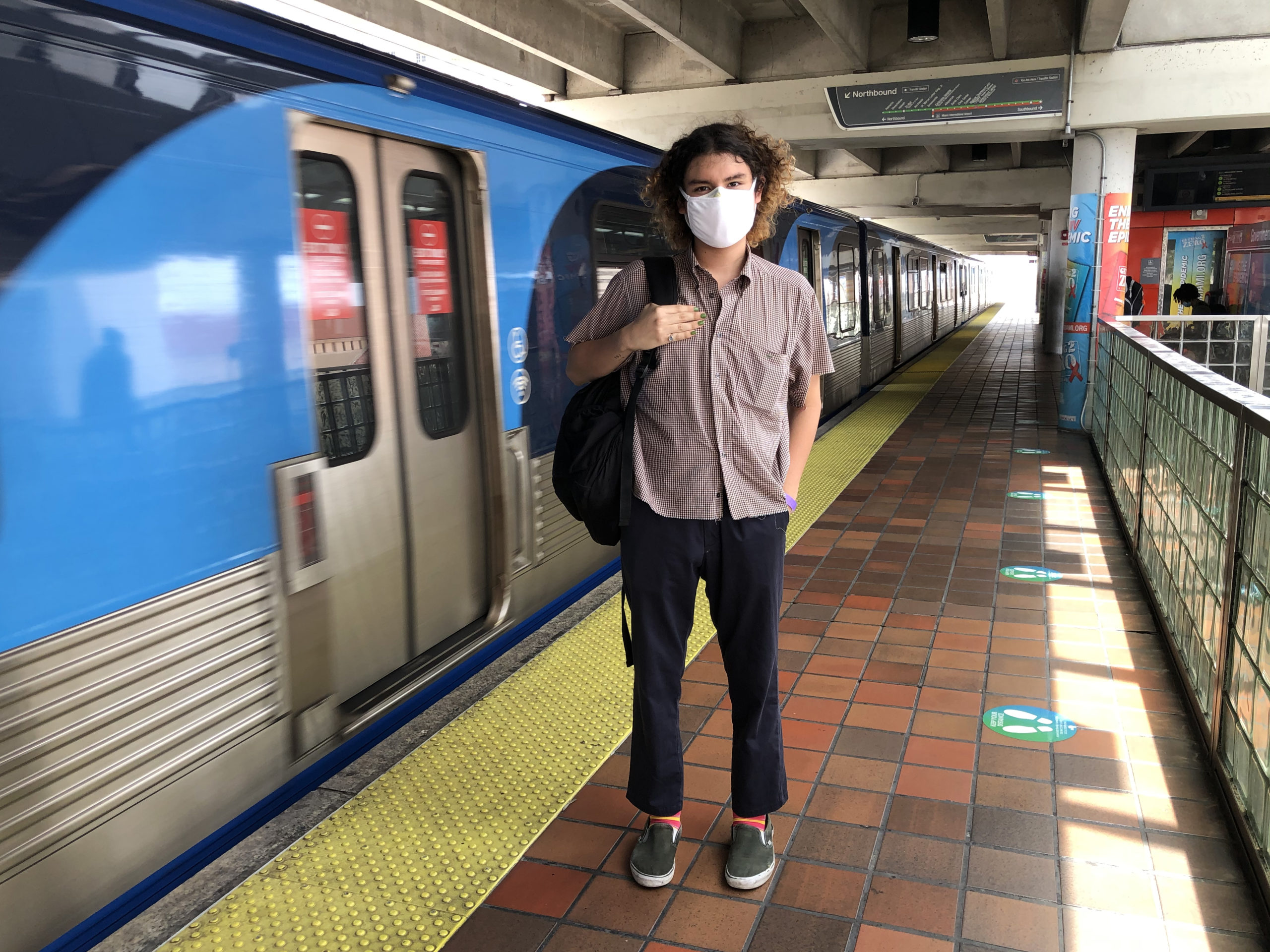 Nic Arce, Miami Springs, FL
Nic Arce, Miami Springs, FL
I was born and raised in Miami-Dade County, and accompanied my immigrant mother who didn’t drive as she went down road after road on the bus to get to work. I started using transit all by myself when I became a college student, commuting to school on my bike and on the train. Even though I can get to the places I need to go, I want to be able to rely on a transit system that can get me to the places beyond what is necessary.
I wish my frequent trips to the southern end of our county could be replaced by a bus or train ride rather than using my car. I wish I could go out with my friends to the beach or to dinner, and be able to rely on a system that could get me back home efficiently and quickly. Currently, I have to use my car to get anywhere beyond my school commute. Our poor transit system sadly poses no competitive advantage over the efficiency of driving my car from Point A to Point B, forcing me to rely on my Kia Soul.
I want my elected officials to make decisions that will advance all of our transit options. It is important to me to speedily expand on both our current network and proposed transit projects in order to get to places faster and happier. I want a network with transit routes that have better connections and less wait times. A network that can take me to the beach, a friend’s house, and thrift stores as fast as my car does.
I’d like to see a mutual commitment to expanding our transit resources between elected officials who care about accessibility and a community who believes that public transportation is an asset worth championing for. A true investment in public transportation means results that not only serve me best, but also prioritizes the needs and wants of my family, neighbors, and friends regardless of where they live in the county.
Illinois
Sarita Cavazos, Chicago, IL
As a full-time college student, owning a personal vehicle has never been fiscally possible. I rely on public transportation to travel to school, work, and extra curriculars.
I’m an out of state college student attending the University of Illinois at Chicago (UIC), my family is over a thousand miles away and I live alone. Public transportation is how I get everywhere: school, work, doctors’ offices, the airport, the grocery store, and so on. UIC’s school shuttles to and from campus are notoriously unreliable, so students who live off campus have had to employ city buses and trains to get to classes on time.
Grocery stores are at least a 20 minute bus ride for me on a good day with no traffic, but I’ve often had to commute upwards of an hour on the combination of two bus routes, or a train and a bus route to make it to a job. If funding for the CTA is cut, my ability to reach necessities and connect with my community will be severely impacted and limited.
Public transit is also affordable, and as a college student this is extremely beneficial to me when expenses like loans and tuition quickly pile up. If funding for public transportation is cut, I could be looking at higher fares for lower quality service, and having to battle with my own personal budget when deciding to choose transportation and other basic necessities.
Transportation connects communities and provides opportunities. If public transit was improved in Chicago, it would help with the massive historical segregation problem that still haunts our city, it would massively benefit our lower income communities, and it would provide our city with a greener, more efficient way to get around while also clearing up our congested city roads.
Lynn Chong, Chicago, IL
During my second year at the University of Chicago, I was given the amazing opportunity to intern for the Chicago Public School downtown headquarters near State St developing programs that can help refugee and immigrant families in Chicago become better integrated into the public school community. As an intern, I had to be in the office for the full workday on Fridays, and my only method of transportation was the Chicago Transit Authority (CTA) since Uber was too expensive (around $40 for one-way trip). The South Side of Chicago where my school is located is not very transit-friendly, so I had to take the 55th bus for about 30 minutes to get to Garfield Station and take the red line subway for another 30 minutes to arrive at Monroe Station. Luckily, my internship was during the warmer seasons, but with frequent delays caused by snow storms in the winter, this commute would have taken well over an hour. This would have been extremely stressful for me as a female student commuting through relatively poorly maintained and geographically isolated subway stations in the South Side, for elongated commute times would have necessitated me travelling alone in the dark. Nonetheless, without public transit, I would not have been able to accept this internship and grow my passion for public service. I also had the rare opportunity to work downtown as a student, which enriched my education and worldview!
To this day, my peers in university find the notion of regularly visiting downtown arduous, and it is. Students are left with the debilitating option of spending an hour to go to an area just 20 minutes away by car or paying $40 to go the same distance. With better public transit, so many more students will gain greater access to valuable experiences outside of the college bubble.

Anthony Medina, Chicago, IL
I am a high school student and a member of the Belmont Cragin Youth Leadership Council with the Northwest Side Housing Center. Transit is a part of my everyday life. I use the bus a lot to get the Housing Center, to basketball practice and the gym, and to see my family and get haircuts.
Transit is important because some people do not have cars and need the bus so they can get to places. I do not have a car, so I’m obligated to bike or bus.
Most of the time the bus does get me to where I need to go, but there are often delays from traffic and during the pandemic I get passed up by the bus a lot. I usually have to get on the bus by 5:50 a.m. to get to basketball practice by 7:00 a.m. and there have been times when the bus passes me up and I can’t make it to practice on time. The same has happened when trying to get to the Housing Center so the Youth Coordinator just tells me to go home and join by Zoom instead. I wish I didn’t have to miss out on basketball practice or Youth Council meetings because of issues with the bus.
Some bus routes in Chicago run more smoothly than others. For example, the Pulaski A route that runs further south is better than the other Pulaski route that comes through Belmont Cragin and Logan Square, because there is less traffic further south. So we would need bus lanes up here to help it run as fast as the other route.
If there was more federal funding for transit, I would want to see more frequent buses on Belmont, Diversey, Harlem, and Central Aves., more bus lanes on those same streets, more bike racks on buses and an app that would allow people to pay before they board so we could get on the bus more quickly through all doors, kind of like how they do it at the Belmont Blue Line Stop.
Bus lanes on Belmont Ave, Diversey Ave, Harlem Ave, and Central Ave would be great so that the bus could roll by traffic rather than getting stuck in it. I’ve seen them in other places, like New York City has them and things run more smoothly when the bus has their own lane.
Right now, there are only two spots for bikes on the bus bike racks. I think there should be at least three spots on the front and back. Sometimes I’m too tired to bike home and want to take the bus, but the bike rack is already filled with bikes, so I have to bike home exhausted.
I would also like transit to be safer. I had an experience on the bus late at night once where there was a man with a knife staring at me and I decided to get off the bus before I reached my destination because I was scared. I wish there were transit ambassadors who had tasers or pepper spray who could help handle situations on the bus because I’ve seen a lot of people mess with bus drivers and get in fights as well.
Transit should also be cleaner, nobody wants to get on a bus that is smelly or dirty. Sometimes I pick up trash I see on the bus but I think everyone should pitch in and do that. People don’t have respect for the bus. If you are taking the bus, you should keep it clean. It’s somebody’s job to clean the bus, don’t make it harder for them. We don’t let people trash our homes, so why do we let people trash the bus?
I also believe the more we can improve transit, the more people will ride transit and then we can have less car pollution and a cleaner environment and community. I’ve cared about the environment since I was young, I don’t like to harm to my community because this is where I’m going to be living and what I’m going to be seeing every day, so it wouldn’t be a smart idea to harm your own community. If you reduce car pollution, things would be more vibrant and trees would be healthier. It will be a good day when people can leave their cars at home and take the bus. Let’s get those bus ratings up to at least a B!
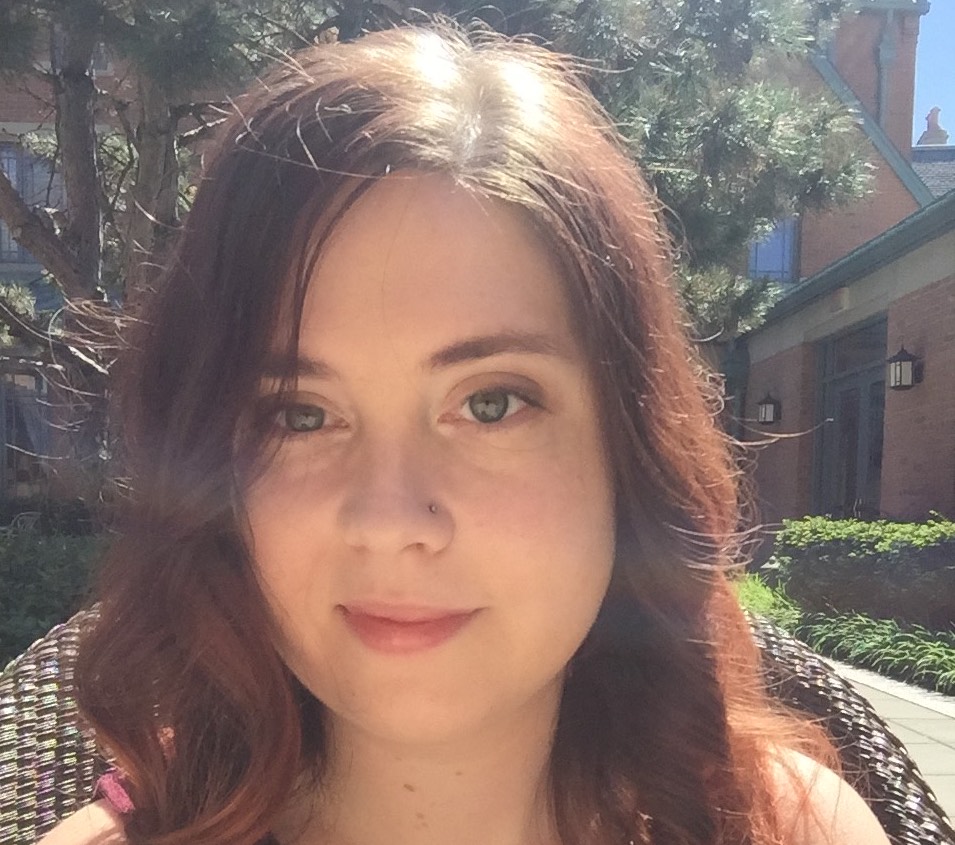 Mary Rachel Taylor, Chicago, IL
Mary Rachel Taylor, Chicago, IL
I'm grateful to have public transportation. I grew up in a town in North Carolina in a town that only had one public bus, but it was very important for me growing up, so living in a place with transit is important to me.
When I was thinking of moving to a new city, one of the factors I took into consideration was, “Does this place have a good public transit system?” This necessity was what narrowed down my options. I considered moving to Portland because I have family there and my degree is in sustainable development, but the transit system there would not meet my needs. That’s why I moved to Chicago. I believed the transportation system that exists here would work for me.
I sold my car when I first moved to Chicago, before having the job that I currently do. At my previous job, I worked in the city and got around fine using transit. Then I got my current job as an Executive Director of a therapeutic equine center for families with disabilities. To get to my job, I have to commute out from the main city of Chicago and into the suburbs. Although a car would be the easiest transportation option, I do my best to take public transportation as often as I can. However, this becomes a difficult task because of the lack of reliable transit that reaches my job.
When I commute to work, I can get within a mile and a half of my office in the suburban area using the Metra. But from the station, I have to call an Uber, ask a coworker to pick me up or walk the rest of the way. On top of that, my job requires me to visit places and move throughout the suburbs, but transit doesn’t allow me to do that. It’s not like I’m going far, this is a suburb of Chicago. It would make sense that there should be some sort of public transportation there, but there is no local transportation once I get there. I am not opposed to walking, but it is not a walkable area either. I soon had to purchase a car just because the transportation wasn't adequate for me to be able to do my job well, and I ended up having to drive.
I would love to be able to take public transportation way more often than I do. Unfortunately, it doesn't work all that well. When I take transit, I have to give myself plenty of lead time to make it to work. I set up my phone to get alerts from the Chicago Transit Authority’s Twitter to prepare for when there are delays, but it happens so often that it became something I was constantly worried about whenever I commuted using transit versus driving my car. It becomes hard to know for sure when the next train will come.
I want to emphasize that I'm not traveling into the city, I do the reverse commute. I live in the city of Chicago and I go out to the suburbs to work, which a lot of people do here in Chicago. A lot of the headquarters of the big brands and corporations are not in the city, they're in the suburbs. So, this is a common problem for a lot of people who live in Chicago. They have to take into consideration that they live in the city for all of the great amenities that are here. Then, they have to sort out how to get to work to be able to continue living in the city.
Upon first moving to Chicago, I was so excited to be able to sell my car and take public transportation. In reality, I can’t depend on public transportation for every aspect of my daily life. The system can be better, and I hope that one day I’ll be able to sell my car again and take transit everywhere I go.
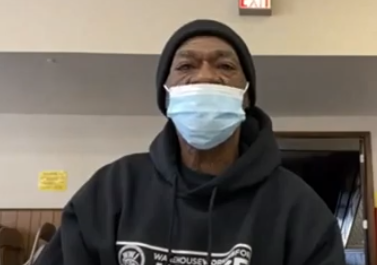
Alfred White, Chicago, IL
I am a worker at a warehouse in Bolingbrook, IL and a resident of the South Side of Chicago. I am also a worker leader with the Warehouse Workers for Justice. I have been working in warehouses for at least five years, but during the pandemic my commute time has almost tripled.
My commute currently takes me six hours, I leave home at midnight to arrive at work at 6:00 a.m. I takes a combination of CTA and Pace buses to get to work. I begin my journey with a walk from my apartment close to the lakefront to the CTA Redline, where I then take to a Pace bus route. I often have to wait an hour for the first run of the Pace bus to make sure I do not miss it, because I know if I am not able to make it on time for my shift, I will probably be fired, which would be devastating. I am already struggling to afford rent and to stay afloat due to my difficult schedule.
Because of how long my commute is, I can’t work full time at 40 hours a week because there are simply not enough hours in the day and I also need time to sleep. It is not the workload so much as the commute that is breaking down my body due to lack of time to rest.
Before the pandemic I was able to work 40 hours a week and my commute was only 2.5 hours due to a combination of service cuts in suburban transit service. I am fearful that I will soon loose housing due to not being able to keep up with this unlivable schedule. I need more frequent buses and trains so that I do not have to wait so long when connecting between train and bus and creating last mile solutions so I can get directly to my workplace rather than having to walk the last leg as well.

Stacey Wingfield, Chicago, IL
I can’t imagine how a city works without public transportation. I depend on transit to get to work, the grocery store, the cleaners, and to see friends and family. In 2014 I decided to get rid of my car for financial reasons. At that time, owning a car for the money I was making, all my extra money was going towards the car. For the money I was making, I wanted anything extra to be able to go towards my quality of life. Now that I am commuting, I get to choose how to use that extra money I save by using public transportation.
Transportation is going to cost you no matter how you choose to get around. So it’s about what is important to you. To me before time was more important – I wanted to be able to jump into my car and get there ASAP. Now I have more time flexibility, I get to choose how to spend the money I am saving by not having a car.
In 2014, I was living in Hyde Park on the South Side of Chicago by the Lakefront at the time, and it was easy to take the #2 or #6 bus to get to work downtown in the Loop. In 2016 I moved to Roseland on the Far South Side of Chicago and came to depend on transit even more with fewer options.
Now I take either the #34 bus or the #119 to get to the Red Line or sometimes I can take the Metra Electric from the State St. stop depending on the schedule. If I lived any further south than Roseland I would probably have to buy a car to be able to get to jobs and groceries and to see family and friends.
When I first moved to Roseland, I started to choose the Metra for the mornings, taking the 8:12 a.m. train which would get me downtown faster than using Uber and getting stuck in traffic on the highway, and I would use CTA Red Line to get home because the Red Line trains run faster after a certain hour and Metra reduces frequency by the evening, and with the Red Line it is easier to stop by stores and visit friends.
I know more people would ride transit if it came more frequently and felt safer. I’m surprised they don’t have more buses that run express like the Metra trains do. I hope more federal funding would help make bus and Metra service more frequent. The Southside needs more buses going far south like the #34 and #119, the North Side has many more routes. I would also like to see more express routes and even for the Red Line to go express for those of us commuting far south. So many people go from Roosevelt to 95th, I think that would make for great express service. We need more weekday evening and weekend service. The Red Line Extension would also be a helpful project and would get more people riding transit.
Maryland
Laurel Mendes, Baltimore, MD
I grew up in Los Angeles. I drove everywhere as soon as i could drive, because that’s what you did in LA at the time.
I drove everywhere for many years until my legs stopped working. I had to give up my car once that happened. Now, I use a motorized wheelchair and I ride the bus.
I’ve been using public transit in Baltimore since about 2016. I retired after working in insurance for 25 years, so I don’t take it to work. But my husband and I volunteer a few days a week at food give-aways around Baltimore City. We have to be at the give-away sites on time to distribute the meals we prepare from donated food items.
These “street feed” events are vital. The pandemic has hit people hard. Whole families come out for meals because they don’t have enough food at home. It’s heartbreaking.
My husband’s eyesight has deteriorated to the point where he doesn’t drive anymore either. We both take the Maryland Transit Administration (MTA) buses everywhere we go.
Even pre-COVID, MTA’s reputation and performance weren’t the best. I often felt, and still feel, “invisible” to bus drivers in my wheelchair. There are times when I wave my arms and bellow, “hello the bus,” and they still act as though they can’t see me. I’ve stopped counting how many times I’ve been passed up, with or without my husband beside me, by bus drivers.
There have been a number of times when the bus’s wheelchair ramp was broken. When the ramp’s broken, the chair can’t board the bus. When that happens, the bus driver just pulls away and we have to wait for another bus. I have learned to make do.
It bothers me a lot. I feel – and I hate this word to describe myself—“crippled” by public transit in Baltimore. But he description is apt.
The published bus schedules are laughable as references. Buses are frequently erratic in their arrival times. Sometimes two or even three of the same route number arrive at the stop within five minutes of each other, then none at all for as long as an hour after that.
I am retired and have some flexibility, others don’t. I have a friend who works less than six miles from her job. She needs to set aside an hour and a half to make certain she arrives on time.
Transit. Employment. Access to food. They are all interconnected.
The troubles I have noted in my testimony do have solutions, if the state and city residents are willing to instruct and empower their legislators and government representatives to do what is needed. Higher investment in transit, so bus maintenance is regularized and schedules met, is needed. Establishing equity measures, so all neighborhoods receive the same high- quality service, is needed. The creation of a regional transit authority encompassing Baltimore City and County, to allow local decision making and direction, is needed.
These three things alone would make significant improvement for more than just transit riders. The old adage is true: A rising tide lifts all boats.
New York
Jackie Goldenberg, New York, NY
I have lived in New York City for 50 years or so. I was a medical editor for a time, and a policy analyst at the Gay Men’s Health Crisis.
Covid has changed my habits drastically. Now, because I’m high-risk, my only means of transit are my feet. I’m extremely cautious, even being fully vaccinated.
Before Covid, I took the subway all the time. I don’t drive and don’t have a car. I was a big subways person. I’d take it at all hours: late, early, at late, every minute. I’m a person who likes to be very mobile. I’d take the subway to see friends in the outer boroughs, or I’d take the PATH to New Jersey. I’m an opera fiend, so I’d take the train back up from the opera at 11 at night. I love looking at all the people. The subway is very much part of the city experience because it’s a great leveler. I like to get on the train and see all kinds of people.
But I think there’s so much more that could be done in terms of public transit. It’s one of the best things about urban life, or it should be. That’s how we can break out of our little pods.
There's been an effort to get elevators in all the subways in New York. It’s a no-brainer. Fewer than 1 out of 4 subway stations in NYC are accessible, and 1 out of 4 people are considered disabled. Those elevators would make a big difference. We should all be able to board the subway in this city, and that’s why I think investment in transit is so important.
Grace Kalmus, Brooklyn, NY
I’m Grace, I work at Home Depot and I use public transit to travel to Hempstead Bay in Long Island from Sheepshead Bay in Brooklyn. Before the pandemic, the trip to get to work took me roughly 3 hours, 2 trains and a bus. By sticking to the bus and subway, I would get transfers and keep my fare affordable. Although the Long Island Rail Road is a much faster and affordable option, the cost would be too expensive for me since the fare is nearly three times the regular bus and subway fare.
For years I’ve had the opening shift at Home Depot, and leave my house at 3:00am to get to work by 5:30am. It's a long and arduous trip that became even more cumbersome at the beginning of the pandemic when Governor Cuomo decided to end overnight service from 1:00am to 5:00am.
This decision has cost me extra hours and money to get to work. Since the overnight closures, I’ve had to take a $25 cab to get me from Sheepshead Bay to Atlantic terminal to then pay for the Long Island Railroad to then pay for a bus in Long Island.
This has added unnecessary cost to my commute, forcing me to pay three different fares to get to work. The other option would’ve been to take nearly 5 buses to get around and wait 30 minutes between buses in the street late at night. It has become a nightmare throughout the pandemic. We need the Governor and Federal Government to provide overnight and reliable service, and provide cheaper and integrated fare options for people like me who can’t afford costly rail to get to and from work.
North Carolina
Natalie Hale, Charlotte, NC
I catch the bus and the train--the Lynx Blue Line. I use it for everything that I can’t walk to because I don’t own a vehicle. If I have to go to the doctor’s office, I catch the bus. That is my mode of transportation. It is my mode of transportation to go grocery shopping. Food shopping and doctors are very important, and I have to be able to get there. If I didn’t have the bus, I wouldn’t be able to get there.
My quality of life would be limited without this mode of transportation. I have no friends here to take me here or there. I thank the Lord for being able to use transit. There is nothing else to depend on to get me there. A lot of people don’t have cars. Not just the elderly. If you don’t have friends or family members to depend on, then you are stuck.
I used to live in Boston, MA. The transit was wonderful. I moved here 3 and half years ago. I googled transit before I moved here. I picked a location next to transit. I deliberately did this. I’m independent. I don’t want to bother with depending on people. I got out of that in Boston. I stopped depending on people. Transit helps me with my independence, and I enjoy it.
New rail and bus could take me to parks or places, recreation or outings that when I get off the bus, wouldn’t be too far to walk to. Implementing some new train and bus service could help me get to destinations that once I get off at that particular stop wouldn’t be as far to walk to--knowing that I’m a senior citizen and can’t walk too far. If I wanted to go uptown at night, to performances or shows, how would I get home?
I’m the president of the homeowners association in my development. People are comfortable with their cars. I know stuff about transit that they don’t know. My grandkids visit and I take them on the bus/train. The little kids love the train/light rail. They need to get out of the suburbs and see life in a new way. The 4-year-old and the 7-year-old love it. I took my granddaughter on the bus. It was a joy to her to take the bus for the first time.
Ohio
Cassandra Barham, Cincinnati, OH
I moved to Cincinnati from New York almost fifty years ago. When my husband came out of the service, he wanted to move home, so I said okay, and came home with him and three kids and a cat. My husband drove me around the city and showed me the landmarks so I could make my way. The bus is how I get around. I never learned how to drive, and didn’t want to anyway.
I know a lot of the bus lines. When I lived out in Forest Park, I used to walk a mile and half to get to the bus every day. First, I was getting my GED, then I did odd jobs, then I went to a building maintenance program. A bit over twenty years ago, I found the Contact Center, where I work as an advocate, helping people go to hearings so they can keep their benefits.
Now I live in North Avondale, little bitty borough. Before this mess, I was going into the Contact Center five days a week, and sometimes Saturday or Sunday for events, taking the bus. I’m not using Metro as much now, but it’s still my only form of transportation if I do go into work or go to a meeting.
That’s not the only way Metro matters to me. My son and my son-in-law are Metro bus drivers. I can’t get on a bus without a driver saying “Hello Ms. Barham, how are you?” Still, I would like all the drivers to be attentive to senior citizens and make sure we’re completely seated before they start driving again. And the city could make it easier for us to get our senior citizen fare cards. The location we have to go is down a hill that is a little difficult for us. It would be easier if we didn’t have to renew them every year.
As important as Metro is, there’s more we could and should do with our transit system here. We have a trolley that really goes downtown and back around. It’s a little quicker because it doesn’t make as many stops. That was the beauty of it. It was a little faster. But the mayor said it wouldn’t go any further because of the cost, and we need it to go up to university. That way the students could use it. And, with investment and attention, our transit system could do more for the elders and people with disabilities who count on transit most.
Theresa Taul, Cincinnati, OH
If it weren’t for Metro, I don’t know where I would be. You can’t depend on people to take you where you need to go. Metro is a big part of my independence as an older person. I take Metro to my doctor’s appointments, to get to the library, to the store, to see my kids, to church. Wherever Metro can take me, that’s the bus I get on. With the pandemic, at first they told us they didn't want us taking buses, but that’s the only way I have to get out. So, for me the bus is a mandatory thing. If I couldn't get on a bus I couldn't get where I needed to go.
One thing I’d like to see is more frequent service. Where I live now in Price Hill, if I miss my bus I have to wait an hour before I can catch another. If you miss that bus, you’re out of luck. Plus, they need to put a bench there so there’s a place to sit while we’re waiting. Even at a lot of other stops they don’t have benches for us to sit down. Where I lived before, the buses ran every twenty minutes and that was much more convenient. I’d also like to be able to get on the bus with my walker without having to fold it up, especially if you use the walker to carry stuff. And, when they let us off the bus, they should make sure we’re close to the corner.
Buses are so important. More hours and more routes that go further or don’t require as much walking would make a big difference. Sometimes you’ll have an appointment in a place where the bus runs only in the morning and then in the late afternoon, so you’re stuck until the route starts up again. It would be good to get a bus running closer to the hospital. For me, four blocks is a long distance to walk.
And we must always make sure anyone can take the bus if they need to. Sometimes you don’t have the money to ride the bus, or you just hope and pray you have enough money in your wallet. There have been times on the bus when I didn’t have a quarter or a dime, and you feel embarrassed to ask people. You see the kids sometimes who don’t have money for their fare, and you wonder, how are they going to get home? From time to time, I’ve taken money out of my wallet to help other people with fares. A dime, a quarter, a dollar. If I’ve got it, I’m going to give it up.

Jess Wallace, Cleveland, OH
I moved to Cleveland 16 years ago, from a small town in Ohio where there is no public transit. As a person living with a mobility disability, Cleveland's public transit system gave me a newfound freedom. I am able to commute to my full-time job at Downtown Cleveland Alliance in downtown Cleveland from where I live in Shaker Heights. It takes 20 minutes on the Green or Blue light rail lines, plus a ten minute journey in my motorized wheelchair. Transit is also my primary way to access entertainment at the nearby art museum and botanical garden, using the #48 bus to get there. I also rely on it for life’s necessities, such as making it to my doctor’s appointments or going grocery shopping.
Without better transit service, I might be forced to move back to my family home and end up relying on governmental assistance. Without transit, I wouldn’t be able to go essentially anywhere independently and my life would be completely different. I don’t qualify for certain independent accessible transportation options. Ride sharing services do not have accessible vehicles, and their services are too expensive. I might be forced to learn to drive an accessible vehicle, which would be a lengthy process and an expense I cannot afford. Public transit is the sole reason I moved to Cleveland, as I knew it would provide me the independent life I had longed to achieve.
In my first few years of living in Cleveland, using public transit was a struggle; not every train station was accessible and many buses had broken ramps. However, whenever there is more investment into this public service, the difference makes a huge impact. For example, once they updated their bus fleet and the stations to make them more accommodating, everything became easier. I depend on these systems to get back and forth to work every day and to live out my daily life. Without our public transportation system, I would not be able to maintain my independence whatsoever.
Without transit, I would not be able to work, have money or live independently. Without transit, I wouldn’t be able to do what I do. Transit service is incredibly important to me, my livelihood, and my community.
Lynn Williams, Cincinnati, OH
I love public transportation. I use it every single day. When I lived in a rural area, I used to drive. But I stopped driving after I moved here because I was born blind in my left eye, and in the city there’s a lot more traffic. You need both eyes to drive in heavy traffic. So, I sold my car and now use the Metro bus system. My bus runs every 20 minutes and is very convenient. I use my commuting time to read and catch up on my work as lead organizer at the Contact Center.
The Contact Center is a community organization that helps people with one-on-one advocacy so they can participate in programs like SNAP or Medicaid. We help them at hearings if they’ve been denied benefits or cut off from programs, and we also do community organizing to expand these programs and protect them from cuts. Our organization also provides a support network and a community where people meet and share what’s going on in their lives.
Fortunately, there are six Metro stops within a block of the Contact Center, including two that stop almost right in front of our door. This is tremendously convenient! We provide bus fare so our members can get back and forth to meetings. Public transit makes our work possible and helps organizations like ours create a place where people can enrich each others’ lives.
The majority of our members do not live close to the Contact Center. They all use the bus to get around, like I do -- not just to come here but do grocery shopping, go to appointments, and so on. They can’t afford cars with the cost of repairs, gas, insurance, and so on.Plus, Metro buses are wheelchair accessible, too, and the newest buses are wifi- connected. Public transit is a huge plus for the environment because it takes many cars off the road. And, right now, Metro bus makes it possible for people to travel to Cincinnati's only mass vaccination site to obtain the coronavirus vaccinations, which I did this week, and it was very convenient.
Sonny Williams, Cincinnati
I’m a 73-year-old disabled veteran with PTSD. After spending some time in different places around the country, I came back to Cincinnati. I use the Metro, our bus system, to get to my VA appointments, the grocery store, and the bank. I move around with a cane.
Even with the pandemic, I’ve never stopped riding the bus. I’ll be riding one today. That’s the only way I can get around. I don’t drive. If it’s raining or snowing, or if there’s a storm, I take the bus even though I might have to stand in the rain. It’s a lifeline for where I need to go.
We need public transit to be affordable for everyone. In Cincinnati last year we voted for taxes to run the Metro, and they’re still raising the fares. The fares are going from $1.75 to $2.00, saying it’s easier for people to pull $2.00 out of their pocket than $1.75, which is ridiculous. The cost of a fare card for an elderly person is going up $5.00 a month. Rather than raising costs, we should keep fares down so everyone can take public transit as they need.
When I got out of the military, I lived in Chicago for a couple of years and worked as a security guard at a hospital, and I realized they had 24-hour transit. That helped me because sometimes I had to work very late, and I could get out and jump on the bus or subway and get home. In Cincinnati, having 24-hour transit would mean people could get to work any time. If someone has a shift where they get off at 2:30 in the morning, they have to get a ride from somebody with a car, and if they don’t have a ride with a friend or someone they know at work, they won’t be able to keep that job. With 24-hour service, there’d be more job openings and people would have more possibility for an income to keep them from getting evicted or from going hungry.
Transit is about opportunity. Here, there are people who want to go to work in suburban areas they can’t reach because they depend on someone with a car. If we had more transportation to suburbs there’d be more opportunities for people. That’s why I support more investment in transit.
Pennsylvania
Jackie Williams, Philadelphia, PA
My name is Jackie. I’m in my 60s, and I use transit everyday to get to work, attend meetings, do my grocery shopping, and to visit friends and family. I wasn’t always dependent on transit, but once I made that switch, I noticed all the barriers that exist for where I can go.
I live in West Philadelphia, where there's plenty of transit, but once I go outside of this bubble, it takes me a long time to get to most places. If I have to go to Northeast Philly, or South Philly, it can be a very long journey. I soon realized that I had really limited myself to where it was easy to get on and off public transportation. So there are a lot of places that I don’t go to simply because it would take too long to get there. These areas have a transit line, but not enough service, so you probably won’t get there in time, if at all.
I work with a small non-profit as their Director of Operations. If there was a community meeting I wanted to go to, I would do my best to go. But for many meetings, when I know transit wouldn’t get me there reliably, I sometimes have to choose not to go. Even when I have to go shopping, I have to take transit into consideration. For example, there's a Home Depot out on Baltimore Pike that has more products in it than the ones in the city. Just to get out there, I have to make arrangements with someone to give me a ride. I knew I couldn't rely on public transportation. This limits me when I need to buy specific products, because what you can buy in the city is different from the suburbs.
Where I live, we have access to many transit options. We have the elevated subway. We have buses. It’s almost like a transit hub. But even then, I don't think there's enough service. There's a lot of options, but you have to wait a long time for the next ride to come. The bus that’s two blocks away from me comes about every 20-25 minutes, which is not frequent enough, so I don't get on that. Instead, I walk six blocks to get to another bus because that comes more often, every ten minutes.
If transit was more frequent, accessible, and reliable, I would be able to reach more places throughout the day and night. For example, I avoid going out past 6 PM because the buses are not frequent at night, and I face the risk of being stranded because of unreliable transit. If the bus came more regularly outside of rush hours, I would have many more opportunities to meet my friends and be out in the city.
I moved to Philly because of increased opportunities and extensive public transportation. Having reliable transportation has given me peace of mind and helped me to feel safe as I move around the city. The frequency, accessibility, and reliability of transit shapes my daily activities, and not in a good way. Having lived here for as long as I have, I know that transit in Philadelphia needs to improve.
